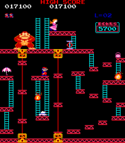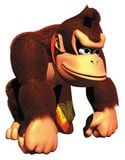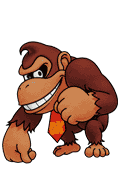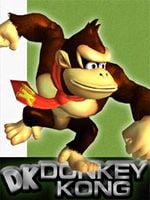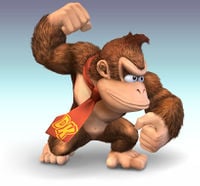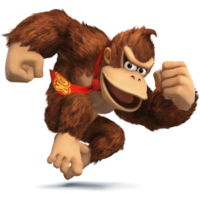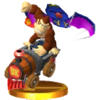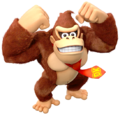Donkey Kong
- For fighter info, see Donkey Kong (SSB), Donkey Kong (SSBM), Donkey Kong (SSBB), Donkey Kong (SSB4), and Donkey Kong (SSBU).
- For the universe, see Donkey Kong (universe). For other meanings of Donkey Kong or DK, see Donkey Kong (disambiguation), Smasher:DK, or Smasher:dk.
| Donkey Kong | |
|---|---|
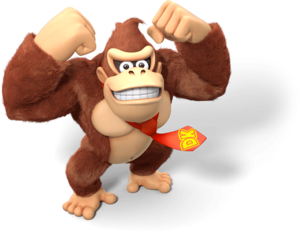 
Official artwork of Donkey Kong from Donkey Kong Country: Tropical Freeze. | |
| Universe | Donkey Kong |
| Debut | Donkey Kong (1981, original) Donkey Kong Country (1994, current) |
| Smash Bros. appearances | SSB Melee Brawl SSB4 Ultimate |
| Most recent non-Smash appearance | Donkey Kong Bananza (2025) |
| Console/platform of origin | Arcade (original) Super Nintendo Entertainment System (current) |
| Species | Kong |
| Gender | Male |
| Place of origin | Donkey Kong Island |
| Created by | Shigeru Miyamoto |
| Designed by | Shigeru Miyamoto (Donkey Kong) Kevin Bayliss (Donkey Kong Country) |
| Article on Super Mario Wiki | Donkey Kong |
Donkey Kong (ドンキーコング, Donkey Kong), also known simply as DK, is the main protagonist and a major antagonist of the Donkey Kong series, and a recurring character in the Mario series. Unlike other Nintendo characters who typically exist as a single entity, the character of Donkey Kong manifests as two separate people in-universe: the original Donkey Kong who served as an antagonist for Mario, revealed to have grown up to become Cranky Kong, and his grandson, the current Donkey Kong who debuted as a heroic character in Donkey Kong Country, and also appears as a featured character in Mario spinoff titles and a villain in the Mario vs. Donkey Kong series.
As a member of the "perfect-attendance crew", Donkey Kong has been featured as a playable character throughout the entire Super Smash Bros. series.
Origin[edit]
Original Donkey Kong[edit]
Donkey Kong was created by Shigeru Miyamoto as the titular character of the arcade game of the same name, based on the character Bluto/Brutus from the Popeye cartoons.[1] According to Miyamoto, he chose the name "Donkey" to reflect the character's stubbornness,[2] while "Kong" was chosen as a surname due to being considered a generic term for large apes in Japan.[3] Although Miyamoto was informed by Nintendo of America staff that the word "donkey" is not a synonym for "idiot" in English despite what the dictionary he consulted had said, he nevertheless decided to ignore this particular suggestion because he liked the name "Donkey Kong".[2]
In Donkey Kong, the titular ape is Mario's first enemy who held his girlfriend, Lady (later known as Pauline), captive over a construction site. Mario had to make his way to the top of the site to rescue Pauline from Donkey Kong - in the first level, 25M, Donkey Kong would begin by jumping so hard that the girders tilt, and impede Mario's progress by throwing barrels, but in the later levels he would simply stand by and let the enemies do the work. Donkey Kong would later return in Donkey Kong Jr., which saw his young son rescuing him from Mario's captivity. He would once again be featured in Donkey Kong 3, which saw him go up against Stanley the Bugman. Donkey Kong would prove to be a highly popular character, spawning cartoons, cereal, toys and multiple other merchandising ventures - though a lot of said merchandising would portray Donkey Kong as a misguided animal instead of a villain, somewhat foreshadowing the character's future - eventually, Mario would begin appearing in games without Donkey Kong, and following the success of Super Mario Bros., the gorilla would disappear into the background, with his son receiving very infrequent cameos in Mario games such as Mario's Tennis and Super Mario Kart.
Modern Donkey Kong[edit]
For a time, Donkey Kong seemed to be largely forgotten in the video game industry, that is, until former Nintendo partner Rare developed Donkey Kong Country for the Super Nintendo Entertainment System, released alongside a new instalment in the classic arcade DK series for Game Boy. Donkey Kong Country saw the debut of a new Donkey Kong alongside a new supporting cast including his chimp friend Diddy Kong, loyal rhino steed Rambi, and nemesis King K. Rool; the new Donkey Kong sports a characteristic tuft of hair and signature tie, and has a somewhat slimmer and muscular physique. This Donkey Kong was said to be the son of Donkey Kong Jr., with the original Donkey Kong taking the title of "Cranky Kong" and appearing as an elderly character who complained about the modern state of the gaming industry through meta-humor. Compared to his grandfather, Rare's DK is most consistently depicted as a laid-back, simple-minded character who only retaliates when either his friends or prized banana hoard are threatened. In Donkey Kong Country 2, DK would not be playable, and instead would have been kidnapped by Kaptain K. Rool, meaning that players would control Diddy Kong and the new character Dixie Kong instead; a role he would reprise in Donkey Kong Country 3, followed by a complete absence from Diddy Kong Racing, before DK would become the main protagonist of a Donkey Kong game again in Donkey Kong 64, where he had to rescue the other Kongs and team up to stop King K. Rool from blowing up the DK Islands with his Blast-O-Matic.
Following Microsoft's acquisition of Rare, the Donkey Kong franchise would exist in a somewhat unusual place, receiving multiple experimental spin-offs, most notably the peripheral-based rhythm series Donkey Konga where Donkey Kong discovers magic bongos and performs licensed music - this would change with the release of Retro Studios' Donkey Kong Country Returns in 2010, a continuation of the Donkey Kong Country franchise where DK once again has to retrieve his banana hoard, this time from a new organization of villains named the Tiki Tak Tribe, who can hypnotize animals - although the Kongs cannot be affected by it - the ending of the game infamously has Donkey Kong perform a comically exaggerated feat of strength, punching the moon so hard that it falls to the ground and destroys the Tiki Tak Tribe's base. This would be followed by Donkey Kong Country: Tropical Freeze in 2014, where DK Island has been thrown into a state of perpetual winter by the Snowmads, a sea-faring organization of arctic and antarctic animals, such as penguins, walruses, owls and rabbits, based on stereotypical depictions of Vikings, and the Kongs have been exiled, where they must return to the island and save it. After an eleven year hiatus with no new original titles, the Donkey Kong series returned with a brand new title exclusive to the Nintendo Switch 2: Donkey Kong Bananza. This title sees the titular character teaming up with a child version of Pauline in a race to the center of the planet against the nefarious Void Company, a mining operation overseen by three new Kong villains.
Additionally, Donkey Kong remains a part of the Mario universe, appearing in many of the Mario spin-off games since Mario Kart 64. Donkey Kong also appears as baby DK in Yoshi's Island DS, the main playable protagonist of the Donkey Kong Adventure story expansion of Mario + Rabbids Kingdom Battle, the primary antagonist of the Mario vs. Donkey Kong series and as an ally to Mario in The Super Mario Bros. Movie. Though relatively unchanged, his design has been slightly changed since Donkey Kong Country. Starting with Mario Kart 64, Donkey Kong was given an updated design with more detailed fur. His appearance in 2002's Mario Party 4 onwards mark the first use of the current variation of a design that would see consistent use up until 2025, with fur colored a lighter brown, more detailed fur, in addition to more realistic proportions than his prior design. Starting with The Super Mario Bros. Movie, a new Donkey Kong design has been introduced, harkening back to the 1980s-era design, most notably with a softer brow and more cartoonish eyes.
In Super Smash Bros.[edit]
As a playable character[edit]
Donkey Kong makes his first appearance in a fighting game as a starting playable character in the original Super Smash Bros. His design is based on his appearance from Donkey Kong Country. DK is surprisingly fast for his size and, damage-wise, is one of the strongest and sturdiest characters in the game. His neutral special move is Giant Punch, which becomes stronger depending on how long the player lets DK charge it before using it. His up special is Spinning Kong, which causes DK to spin around wildly with his arms striking anyone nearby. His down special move is Hand Slap, which allows DK to pound the ground with his fists repeatedly creating a small earthquake. While his attacks are powerful when they land, his high weight, lack of projectiles, and slow attack speed result in him being very easily susceptible to combos and struggling to catch up to faster and longer-ranged characters. As a result, he is ranked 9th out of 12 on the current tier list.
His in-game description is as follows:
- Donkey Kong
- Donkey Kong and Mario started out as arch-rivals, but they've patched things up in recent years. These days DK spends his time searching the jungle for bananas instead of kidnapping beautiful maidens. In the past few years, other members of the Kong family have cashed in on DK's fame as well, including his favorite nephew, Diddy.
- Works:
- Donkey Kong (Arcade),
- Donkey Kong Country (SNES),
- Mario Kart 64 (N64)
In Super Smash Bros. Melee[edit]
As a playable character[edit]
Donkey Kong returns in Super Smash Bros. Melee as a starting playable character. His appearance now somewhat resembles his design from Donkey Kong 64, albeit with a yellowish skin tone. He remains mostly the same from the original, but his new side special move, Headbutt, allows DK to embed his opponents into the ground giving him some free hits. As before, he is incredibly strong and agile, capable of walking and jumping while carrying Crates, Barrels, and Party Balls, items that normally decrease a character's walking speed and cause them to become unable to jump. He is also no longer the heaviest Super Smash Bros. character; newcomer Bowser surpassed him. Donkey Kong is now ranked slightly higher, but is still low-mid tier, being ranked 16th out of 26 on the current tier list in C- tier.
Trophies[edit]
As a playable character, Donkey Kong has three trophies - a normal trophy acquired by beating the Classic Mode with Donkey Kong on any difficulty, and "Smash Red" and "Smash Blue" trophies won by beating the Adventure and All-Star Modes, respectively.
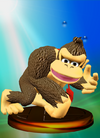
- Donkey Kong
- While he now prefers the laid-back jungle lifestyle to construction site mischief, DK is often forced back into action by the Kremling Krew. The great ape is quite fast despite his burly physique, and he keeps his strength up with a steady diet of his favorite food: bananas. His one extravagance (and only piece of clothing) is a monogrammed necktie.
- Donkey Kong (Arcade 1981)
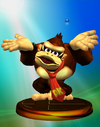
- Donkey Kong SMASH
- Donkey Kong is a huge target in a fight, so he hates crowds. When he's in the fray, his Giant Punch deals serious damage to multiple opponents. The big ape's Headbutt hits so hard that it temporarily buries opponents in the ground. DK is a lot faster than he looks, and he's lethal in the hands of a master.
- B: Giant Punch
- Smash B: Headbutt
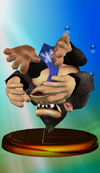
- Donkey Kong SMASH
- Being the strongest simian around, DK has the upper hand once he grabs an opponent. He can even lift his foe up and make him or her an unwilling traveling companion; if DK grabs you, shake your Control Stick as fast as you can to break his grip. His Spinning Kong covers more lateral distance than vertical, so use it quickly to recover.
- Up & B: Spinning Kong
- Down & B: Hand Slap
In Super Smash Bros. Brawl[edit]
As a playable character[edit]
Donkey Kong returns as a starting playable character in Super Smash Bros. Brawl. He is no longer the sole fighter of his series, as he is joined by his buddy, Diddy Kong. His appearance is based on his current design from the Mario spin-off games and the later Donkey Kong games. With new physics in the game, Donkey Kong can no longer be comboed as easily, like in Super Smash Bros. Melee, and his power, range, recovery and speed stats have slightly improved. His Final Smash is Konga Beat, in which DK takes out some DK Bongos and plays them. By timing their button presses, the attack power can be increased. During this move, DK is invincible, but it becomes a bit more risky when playing on a moving stage like Rumble Falls - though the screen scrolls much more slowly while the Final Smash is in action to compensate. He also appears as a stage hazard along with springs in the 75m stage. Donkey Kong is now ranked around the middle of the tier list, placing 21st out of 38 in the D tier.
As a stage hazard[edit]
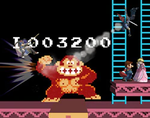
A key part of the 75m stage is the arcade sprite of the original Donkey Kong, who sits on the long platform. He normally sits behind the stage in the background, but will sometimes light up and comes into the foreground. When this happens, the stage's usual background music will briefly fade out and play his theme for a few seconds, giving an opportunity for players to react before he attacks. While he is in the foreground, contacting him causes moderate damage and knockback. Four jacks will also bounce in from the left at irregular intervals (for example, Donkey Kong can throw one jack, briefly pause, and then resume throwing the jacks) and fall after they bounce off the long platform, also causing damage and knockback. After a certain amount of time, Donkey Kong will go back into the background.
Trophies[edit]
Donkey Kong has a trophy that is awarded each time the Classic Mode is completed with Donkey Kong on any difficulty.
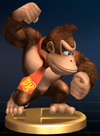
- Donkey Kong
- A carefree jungle dweller with the charisma of a natural leader. He keeps busy by foiling the plans of the Kremlings and their boss, King K. Rool. As his physique suggests, this ape is a powerhouse. He's got speed to match too, and his love for bananas is second to none. His famous necktie is adorned with his initials, DK.
: Donkey Kong Country
: Donkey Kong 64
Stickers[edit]
| Name | Game | Effect | Fighter(s) |
|---|---|---|---|
| DK | Mario Superstar Baseball | ||
| DK with Barrel | Mario vs. Donkey Kong 2: March of the Minis | ||
| Pauline & Donkey Kong | Donkey Kong | ||
| Donkey Kong | Donkey Kong Jungle Beat | ||
| Donkey Kong | Donkey Kong Country | ||
| Donkey Kong | Mario Kart DS |
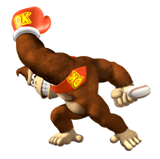 DK (Mario Superstar Baseball) |
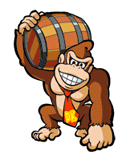 DK with Barrel (Mario vs. DK 2: MotM) |
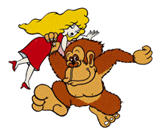 Pauline & Donkey Kong (Donkey Kong) |
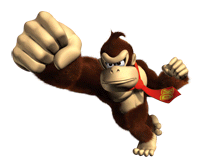 Donkey Kong (DK Jungle Beat) |
 Donkey Kong (Donkey Kong Country) |
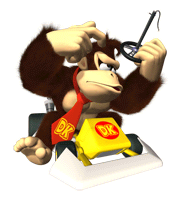 Donkey Kong (Mario Kart DS) |
In Super Smash Bros. 4[edit]
As a playable character[edit]
Donkey Kong returns as a playable character in Super Smash Bros. 4. His design is based on his appearances in recent games, such as Donkey Kong Country Returns and Donkey Kong Country: Tropical Freeze.
On the SSB4 tier list, Donkey Kong ranks 22nd out of 54 characters, placing him in C tier. He has been buffed overall, with faster attacks and improved combo ability, especially with his cargo up throw. The new rage mechanic benefits Donkey Kong very well, which when combined with his heaviness, allows him to deliver greater knockback at higher damage percents. Donkey Kong's trademark power and speed are retained from past games too. Although he is regarded as one of the game's best super heavyweights along with Bowser, he still suffers from common weaknesses that plagued him in the past, such as vulnerability to combos due to his weight and size, and his recovery in Spinning Kong still gaining little vertical distance. Nonetheless, Donkey Kong's strengths have allowed him to secure decent tournament representation and above average results.
As a stage hazard[edit]
The original Donkey Kong reprises his role on the 75m stage in Super Smash Bros. for Wii U, functioning the same way as in Brawl.
Trophies[edit]
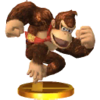
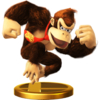
- Donkey Kong
This king of the jungle really, really loves bananas. His adventures usually start with people stealing his hoard of them. In Smash Bros., he's known for his incredible strength and long reach. Despite his size, he's still pretty quick. He can even jump carrying heavy items! Use this knowledge well.
: Donkey Kong Country (11/1994)
: Donkey Kong Country Returns (11/2010)
With help from Diddy Kong and his Animal Friends, this banana-loving king of the jungle will take on anyone causing trouble on his turf. The best things about him in this game are his colossal strength, his speed, his long reach and the fact that he can jump while holding heavy items. Make sure you use all that to your advantage!
: Donkey Kong Country (11/1994)
: Donkey Kong Country Returns (12/2010)
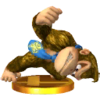
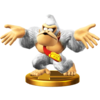
- Donkey Kong (Alt.)
 Donkey Kong pulls no punches when it comes to fighting. Or headbutts, as it turns out. His Headbutt special move will bury anyone on the ground who gets hit, leaving them open to some serious damage. If Donkey Kong strikes an airborne foe with this move, they'll go crashing downward.
Donkey Kong pulls no punches when it comes to fighting. Or headbutts, as it turns out. His Headbutt special move will bury anyone on the ground who gets hit, leaving them open to some serious damage. If Donkey Kong strikes an airborne foe with this move, they'll go crashing downward. Donkey Kong pulls no punches when it comes to fighting. Or headbutts, as it turns out. His Headbutt special move will bury those on the ground who get hit, leaving them open to some serious damage. If Donkey Kong strikes airborne foes with this move, they'll go crashing downward.
Donkey Kong pulls no punches when it comes to fighting. Or headbutts, as it turns out. His Headbutt special move will bury those on the ground who get hit, leaving them open to some serious damage. If Donkey Kong strikes airborne foes with this move, they'll go crashing downward.: Donkey Kong Country (11/1994)
: Donkey Kong Country Returns (11/2010)
Donkey Kong's always been one to use his head. Anyone who's been on the receiving end of his Headbutt special will tell you that. If they're on the ground when it hits them, they'll get buried, leaving them open to a serious walloping. If they're in the air, though, they might find themselves being knocked down. Either way, it's going to hurt.
: Donkey Kong Country (11/1994)
: Donkey Kong Country Returns (12/2010)
- Donkey Kong + Barrel Train
This mean machine may look like it was meant for the tracks, but really it was made to soar. That fine wood finish isn't so great in the water, though. I bet more than a few players have fond memories of the Barrel Train and its first driver, Diddy Kong.
This kart might look like it needs to be on rails, but it's actually great in mid-air. Like any barrel, though, it has a tendency to float. In a race that comes down to speed in water, it'll get left behind. The name "Barrel Train" might ring a bell for Mario Kart veterans – it was Diddy Kong's kart!
In Super Smash Bros. Ultimate[edit]
As a playable character[edit]
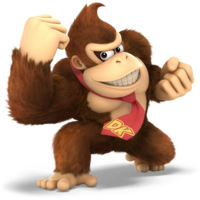
Donkey Kong returns in Super Smash Bros. Ultimate as one of the few characters available from the beginning. He has a new Final Smash in the form of Jungle Rush, which originated from Donkey Kong Jungle Beat. He receives a slight redesign to his appearance in later Wii U games such as Mario Kart 8 and Mario Party 10, where his snout protrudes out instead of being nostrils on a flat surface.
As a stage hazard[edit]
The original Donkey Kong reprises his role on the 75m stage, functioning the same way as in Brawl.
Spirits[edit]
Fighter spirit[edit]
Primary spirit[edit]
| No. | Image | Name | Type | Class | Slots | Base |
Max |
Base |
Max |
Base |
Max |
Ability | Series |
|---|---|---|---|---|---|---|---|---|---|---|---|---|---|
| 137 | Donkey Kong & Lady | ★★★★ | 3 | 4047 | 10119 | 2386 | 5967 | 1432 | 3580 | Strong Throw | Donkey Kong Series |
Support spirit[edit]
| No. | Image | Name | Class | Cost | Ability | Series |
|---|---|---|---|---|---|---|
| 169 | Donkey Kong & Bongos | ★★ | 1 | Perfect-Shield Reflect | Donkey Kong Jungle Beat |
Names in other languages[edit]
Trivia[edit]
- Unlike in most modern Donkey Kong games and Mario spin-offs, where Donkey Kong has a cartoonish voice provided by Takashi Nagasako, the Super Smash Bros. series has Donkey Kong using more realistic gorilla grunts. This also applies to Bowser, with realistic roars instead of Kenneth W. James, Bowser's current voice actor in most Mario games; Petey Piranha, who uses monstrous roars instead of his most recent voice actor in the Mario games, Toru Minegishi; Diddy Kong, who uses realistic chimpanzee screeches instead of using voice clips from his most recent voice actor, Katsumi Suzuki; and King K. Rool, who uses realistic crocodile grunts instead of his most recent voice actor in the Donkey Kong games, Toshihide Tsuchiya.
- Takashi Nagasako is involved in the Super Smash Bros. series, however, by providing the voice of Ganondorf in Melee and Ultimate.
- Donkey Kong is the only character in the series who can walk at a normal speed when carrying a heavy item such as a Crate or Barrel; he also is the only character who can jump and fall while doing so. This originates from his ability to easily carry and throw barrels from Donkey Kong Country.
- Additionally, starting with Melee, Donkey Kong moves faster when carrying heavy items if he is tiny.
- In all games in the Super Smash Bros. series, whenever Donkey Kong uses an item like the Fire Flower or the Ray Gun, he will grasp the top of his head while firing them, as if he is not sure what to make of the weapon.
- Counting sub-series, Donkey Kong is the only overall Mario character who has never been able to produce a projectile with his moveset in the Super Smash Bros. series.
- He is also the only Donkey Kong character to have this trait.
- Despite being able to crawl in their respective home series, Donkey Kong, Mario, Pit, Link, Young Link, Toon Link and Terry are unable to do so in the Super Smash Bros. series.
- Donkey Kong himself is the only character in the Donkey Kong series to be created in Japan. However, his design used in the Super Smash Bros. series has been created in the United Kingdom and is considered in-universe to be a different character from the original Donkey Kong.
- Donkey Kong is one of two characters to be listed by abbreviations on the victory screen, trophies, and character select screen (being listed as DK in Super Smash Bros. and Melee), the other being Captain Falcon.
- Donkey Kong is the only character who has more than four throws.
- Since SSB4, Donkey Kong has the distinction of being the character with the most attacks that have a meteor effect, with a total of four attacks.
- Starting with SSB4, the English-language chanting by the crowd for Donkey Kong when a player performs well is "DK! Donkey Kong!" This is a reference to the popular DK Rap.
- Donkey Kong is the heaviest fighter among the "Original 12", as well as the heaviest protagonist thus far, as the two characters (Bowser and King K. Rool) who are heavier than him are typically antagonists.
- Donkey Kong is the only character to have a move not result in a helpless state in the first game (being Smash 64), then having it result in a helpless state for the next games (from Melee to SSB4), then reverting back to not resulting in such (being Ultimate)—in this case Giant Punch.
References[edit]
- ^ [1]
- ^ a b Kohler, Chris (October 14, 2016). "Miyamoto Spills Donkey Kong’s Darkest Secrets, 35 Years Later. Wired. Retrieved October 14, 2016
- ^ "Donkey Wrong" - An article about the origin of Donkey Kong's name. Snopes.com. 2011. (Retrieved June 28, 2012)
|
| |
|---|---|
| Fighters | Donkey Kong (SSB · SSBM · SSBB · SSB4 · SSBU) · Diddy Kong (SSBB · SSB4 · SSBU) · King K. Rool (SSBU) |
| Assist Trophy | Klaptrap |
| Boss | Giant Donkey Kong |
| Stages | Kongo Jungle · Kongo Falls · Jungle Japes · Rumble Falls · 75m · Jungle Hijinxs |
| Items | Hammer · Barrel Cannon · Peanut · Spring |
| Enemies | Kritter · Tiki Buzz |
| Other | Dixie Kong · DK Barrel · DK Island · Pauline · Stanley · Zinger |
| Trophies, Stickers and Spirits | Trophies (SSBM · SSBB · SSB4) · Stickers · Spirits |
| Music | Brawl · SSB4 · Ultimate |
| Masterpiece | Donkey Kong |
| Related content | Mario (universe) · Banjo · Barrel |
